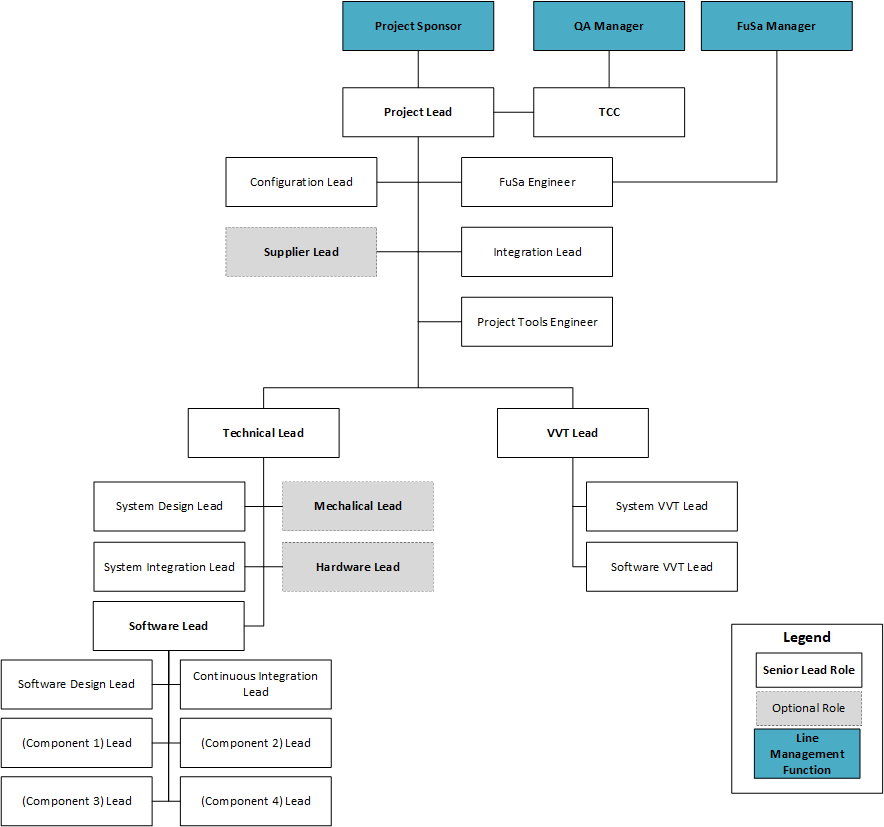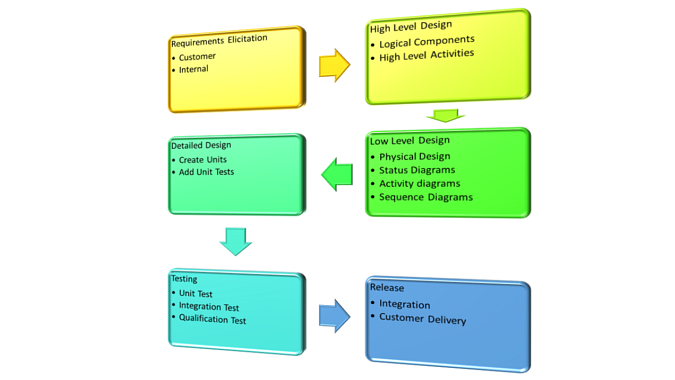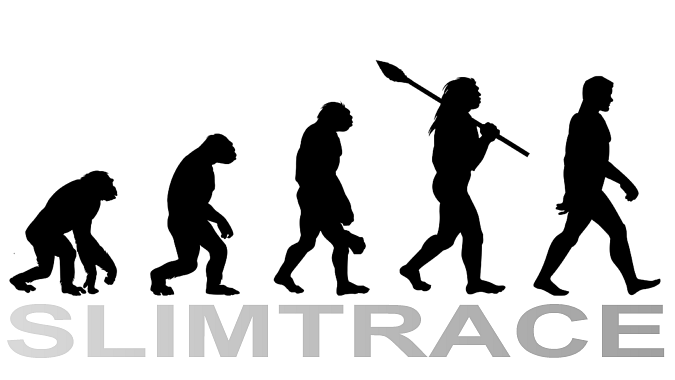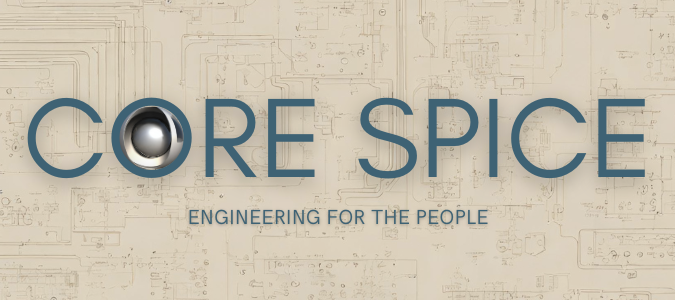
Most quality standards, such as ISO 26262 for functional safety, don’t postulate specific project roles. However, certain project roles, such as project manager, are commonly used in the automotive business. CORE SPICE extends those typical roles as a nucleus of successful project leadership.
Quality standards don’t expect specific project roles within organizations because different industries require different project leadership cultures. For instance, in a typical internet business, Scrum with simple roles–Product Owner, Scrum Master, and “the team”–is sufficient to organize a project.
In the automotive business, however, numerous constraints don’t allow for a random or “self-organized” project structure. Strong project leadership is usually indispensable, especially in systems development projects relevant to safety and security. Attempts to define more novel, progressive roles often fail to meet customer expectations because of a conventional demand for specific work packages and deliverables that developers often perceive as cumbersome or overly bureaucratic.
One critical insight from our decades-long experience in our business is that creating completely new and “groundbreaking,” “bleeding edge” role models is unlikely to solve the project leadership dilemma, which is how to lead an automotive project where many tasks are unpopular with the developers because they are perceived as not adding a significant customer value. At the same time, tight time targets make it virtually impossible to deliver everything stipulated in a development contract. In such an environment, it appears a natural reflex to seek a “quick fix” to this frustrating challenge. From our perspective, however, attempting to escape this “trap” by some kind of a “transformation” is an example of magical thinking, eventually resulting in relentless task force meetings and an increased likelihood of disastrous project failures.
Balanced set of conventional roles
CORE SPICE offers a balanced set of roles closely aligned with automotive business models, presenting a simple, conventional, and well-proven team model solution to this dilemma. It is not a “silver bullet” to our commonly occurring project organization issues. Instead, the positive acceptance of a conventional team structure resolves the tension that often stems from discussions about methods and process models. There is no need to reinvent the proverbial wheel just because that wheel is broken in a particular project. Instead, fixing the wheel by establishing an efficient, trusted project structure, where team roles are owned by experts with a known track of technical and ethical standards, makes it whole and effective to roll again toward the project goal.
CORE SPICE defines conventional roles such as Project Lead, Configuration Lead, Technical Lead, and Verification and Validation Lead (VVT Lead). Automotive industry insiders will surely instantly recognize the meaning of those project roles.
Therefore, we won’t describe all of those roles in detail; instead, we focus on one example role: the Project Lead.
Before we do that, however, we want to explain the role-naming approach. We have intentionally avoided using specific traditional role names because they may remind us of anti-patterns in project organizations, where particular roles were used differently from their meaning defined in standards like PMBoK. For instance, a “project manager” role is frequently a “project coordinator” role instead–a role that does not imply substantial decision-making empowerment. Also, as opposed to “project manager,” the plain term “manager,” particularly in non-English-speaking countries, is often associated with corporate status and formal power in a line organization, where project-specific outcomes may not be at the core of the job description. We used “lead” instead of “manager” in CORE SPICE role names for those reasons.
The term “lead” suggests a “leadership” responsibility, which is critical in systems development projects. CORE SPICE roles imply a high level of leadership skills. The role of the Project Lead is, in this context, the most distinct CORE SPICE role. Therefore, we will use the role of Project Lead as an essential example of the CORE SPICE project leadership. Other CORE SPICE roles are consistent with the semantics of this role.
Responsibilities of the Project Lead
Examples of Project Lead responsibilities include:
- Project scope management.
- Personnel planning, recruitment, and team development for the project.
- Designation and monitoring of team roles.
- Encouragement and supporting team members to increase efficiency and motivation.
- Scheduling, organizing, and following up on planning workshops.
- Creation, review, and approval of project documents, such as the Project Approach and work breakdown structure and effort estimates.
- Continuous monitoring of the project schedule and adjusting it as required.
- Monitoring project progress and deliveries.
- Managing and monitoring the project budget, including cost control.
- Ensuring compliance with deadlines, milestones, and project objectives.
- Updating and maintaining documentation, including meeting minutes and open issues.
- Ensuring compliance with CORE SPICE requirements and relevant industry standards.
- Proactively resolving project-related conflicts and disputes.
- Building and maintaining relationships with external stakeholders, including suppliers and partners.
- Planning, organizing, and implementing targeted training measures for the project team.
- Maintaining and updating project knowledge.
- Inspiration of the project team on all levels with consistent, ethical, merit-based leadership-by-example.
This comprehensive list of responsibilities suggests that being a Project Lead requires a unique skill set. Such insight resonates with the continuous call for leadership talent in our industry. Those skills can be taught and trained, but such training programs must be tailored to the specific needs of our industry. A few training programs of this kind exist, such as Automotive Project Management Foundation or Project Manager in the Automotive Industry.
Examples of essential skills of a Project Lead include:
- In-depth project management knowledge, preferably certified (e.g., PMP).
- Ability to develop detailed project plans, including schedules, milestones, and resource allocation.
- Ability to identify potential risks and development of mitigation strategies.
- Understanding of testing and validation methodologies.
- Understanding of the V-model and agile processes.
- Excellent automotive industry knowledge, including vehicle systems, components, and functions.
- Familiarity with automotive standards such as ISO 26262 (functional safety), Automotive SPICE, cybersecurity ISO 21434, CORE SPICE, and knowledge of industry-specific certifications required for automotive products (e.g., ISO 16949) and AIAG standards (such as PPAP).
- Understanding of vehicle electronics, mechanics, and software.
- Ability to manage and foster relationships with key project stakeholders with empathy and integrity.
- Thorough understanding of design tools used in automotive development.
- Knowledge of emission standards and other environmental regulations.
- Ability to find solutions to unforeseen challenges and problems.
- Willingness to continuously learn and keep up to date with the latest trends in the automotive industry.
- Ability to inspire the team and foster charismatic leadership skills.
- Ethical integrity on all project levels.
Passion for technology and relentless conscientiousness set the standard for a successful Project Lead.
An effective Project Lead demonstrates technical proficiency and leadership skills, emanates passion and positivity, and inspires innovation. They navigate complex challenges with a solutions-oriented approach, growing an environment where creativity and efficiency thrive among all teams. Project Leads drive their teams forward, turning ambitious visions into tangible results. An embodiment of proactive leadership, they ensure that projects meet and exceed expectations, setting an actual role model for excellence in the industry.
The inspirational aspect of project leadership cannot be overstated. A Project Lead must be able to communicate the project mission as effectively and credibly as Steve Jobs did when he unveiled the first iPhone. Of course, not everyone can have the charisma of Steve Jobs, but they should at least become the role models to aspire to.
A Project Lead must also have fully internalized the purposefulness of a project and be able to communicate its purpose to the team and other stakeholders. This is a vital leadership quality, along with the curiosity and willingness to continuously learn new technologies and innovative product frameworks. It is essential because our industry has gone overdrive regarding technological progress. From the original comfort zone of ICE motors, where software was a nuisance and a new car took long years to reach the market, modern cars have become fast-paced vehicles of technological avant-garde packed with software and semiconductors. Almost every modern car system development project involves new and innovative solutions. Many prototypes and technologies have never been used in practice, pushing the borders of laws of physics and pursuing “mission impossible” projects in which new technological boundaries must be broken and conquered. It is an open secret that many component developments are incredibly daring. We have experienced product developments that bordered on madness but were successfully delivered against all odds and are now used in hundreds of thousands of vehicles daily. For an excellent Project Lead, such challenges are motivating and an incentive to inspire their teams and to excel at the principle of leadership-by-example.
Being a Project Lead is a personal choice
Joint roles (two people sharing the Project Lead’s responsibilities) are not permitted in CORE SPICE. A Project Lead is always an individual in the project. Of course, to support a Project Lead, one or more “deputies” can be defined for each role, but core role holders like the Project Lead always bear full responsibility for their direct team members. This personal responsibility provided that this responsibility is underpinned by the formal authority of a Project Lead within the line organization, allows for a higher confidence level of a project lead. Thanks to such a clearly structured role, a Project Lead can fully internalize the project mission, which emanates into the entire project team, creating high confidence in the overall project goals among all teams.
It may sound like we are attempting to establish a Project Lead role as some kind of an authoritarian position in a project. This is not our intention. Instead, we want to ensure that a project structure is efficient, as outlined in the article Efficient Adaptive Team Structure,” where slim but hierarchal project responsibilities allow for clear and fast decision-making abilities.
As outlined in the above team chart, the fundamental project roles must be assigned to people with a similar attitude as the Project Lead for any project in our industry to succeed. This “core” team is crucial for the project’s success, and they need to be a tight-knit group of project leaders who share the values and the goals, thus ensuring no redundant discussions arise.
“Nothing works–until you do!”
In critical situations in automotive projects, especially in product development projects that fail to deliver the desired results for an extended time, a call for “strong leadership” frequently arises. As a famous proverb goes: “Desperate times call for desperate measures.” Unfortunately, such an approach sometimes produces even more desperation and erratic measures. Reorganizations, restructuring, novel development methodologies, makeshift roles with well-sounding names, and various “silver bullet methodologies” make their way into such troubled project environments.
The CORE SPICE roles offer a simple “default fallback” team structure in such cases. These roles are well-established, easy to explain, intuitive (at least in the context of the automotive business), and can be instantly (re-)introduced and established within a few days. However, even a cleaned-up and de-cluttered project structure still needs a sound vision of the projectized organization. In other words, the role owners must be allowed to do their jobs without the bureaucratic impediments of matrix organizations and any distracting mythical methodologies and ideologies. A strong Project Leader–the only “strong leadership” that is required in this case–and the team must be allowed to delegate and report the status on all levels so that the entire team always knows the progress of all critical deliverables and thus the risks that often frequently arise in such cases.
We suggest establishing simple rules that promote a clear sense of responsibility for CORE SPICE teams. For example:
- Instant responsibility: If you notice a project issue or a substantial risk, you are instantly and personally responsible for the resolution until you either resolve it or find a qualified expert in your project.
- No task left behind: No task must exist without a person assigned to it. “Ownerless tasks” take the longest to resolve. When a task takes a long time (like a year – a very long time in a fast-paced automotive business), it is probably redundant or poses a high risk. In both cases (see rule 1).
- Nothing works unless you do: Stop talking about what must be done, do it yourself, or delegate it (see rule 1).
If these rules sound simple, then that’s because they, indeed, are simple. Such simple rules are effective because they foster a sense of personal responsibility (as opposed to collective responsibility). CORE SPICE roles support the leadership spirit, which is in high demand across our industry, especially in complex projects.
Simplicity and accountability are key
Setting up CORE SPICE roles is straightforward. We don’t necessarily have to implement this role model unchanged. We can use the CORE SPICE model as a template and tweak it until it fits our specific organizational purpose. This makes it easier for teams to get on board and use them immediately. In short, CORE SPICE roles combine the best of our knowledge with proven work methods.
However, implementing CORE SPICE roles goes beyond just placing those roles on a team chart. Roles must be brought to life and practiced with dedication and responsibility for each assigned CORE SPICE role. In CORE SPICE, there is no room for lack of accountability or an opportunity to adopt a “not-my-job” mentality. It seems surprising that we must emphasize such simple rules in a professional automotive environment. Those rules are nothing new, yet they often don’t receive the attention they deserve. As the ancient Romans used to say, “nihil novi sub sole” – nothing is new under the sun – and CORE SPICE is not substantially different from what we have known in the past. That’s the strength of the CORE SPICE role model: it reflects decades of practical industry experience. It has worked well when genuinely implemented, and there is no need to discard it as part of automotive history. No novel, progressive methodologies will be successful if an organization cannot effectively execute such conventional roles.
As an additional incentive, the CORE SPICE roles are consistent with Automotive SPICE – a standard that does not define roles but implies responsibility and accountability in project organizations. Other essential standards, such as ISO 26262, ISO 16949, and ISO 21434, are also compatible with this project roles model. Thus, CORE SPICE is an easily extendable, generic role model suitable for every automotive systems development project.
The beauty of CORE SPICE role model lies in their clear and simple approach and alignment with the automotive industry’s needs. These roles are not just easy to understand and use; they can also serve as a career path template, as outlined in the article The T-Rex Company on projectcrunch.com. CORE SPICE paves the way for global standardization and simplification of responsibility models in our industry. It thus deserves the attention of any automotive organization tasked with simplifying and streamlining systems development.
Let’s start a conversation on LinkedIn or X.com (formerly Twitter).








